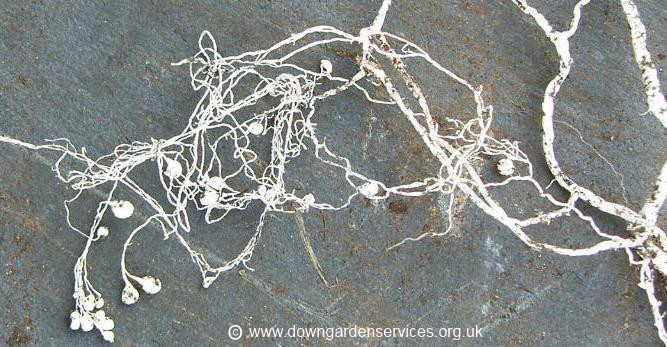 The white mycelium of a mycorrhizal fungus found close to the roots of a recently planted rose bush. The white mycelium of a mycorrhizal fungus found close to the roots of a recently planted rose bush. Mycorrhizae are very specialised organisms in the Order Glomales, which are found in close association with about 95% of all plants. (The name mycorrhiza comes from the ancient Greek for fungus and root.) It is a symbiotic relationship where both organisms derive benefit - the fungus is unable to photosynthesize and fix its own carbon so it takes some of the carbohydrates which the plant passes down to its roots. In exchange the plant receives essential nutrients and water from the fungus which has an extensive mycelium structure that reaches out further than the plant roots, so it forms a secondary root system. They also help the plant to withstand the stress of drought and prevent some of the soil-borne pathogens such as Phytophthora and Armillaria from entering the roots.
Examination of fossil plants and studies of DNA sequences, show that this relationship has existed for over 400 million years. It should not be confused with the rhizobial bacteria which have a symbiotic relationship causing root nodules that fix nitrogen. Immobile soil nutrients such as Phospherous (P), Copper and Zinc are made more available, The level of P is important, as at very low levels the fungus competes with the plant for P so it is parasitic, at high levels the plant does not need the fungus and the association will not occur.
The mycelium has also been shown to thansfer carbon and nutrients between plants as demonstrated using radioactive carbon injected in to a tree which was subsequently found in a neighbouring tree some time later. This can be important where the neighbour becomes shaded or stressed. Trees can also pass indicators that they have come under attack from pests so neighbouring trees start to increase the concentration of defensive chemicals in their sap.
As they move nutrients and moisture around, they are very important in 'no dig' methods of growing such as Permaculture. Also cultivating the soil damages the mycelium so reducing their effectiveness. The outer sheath of the hyphae has a substance called glomalin, a glycoprotein which is sticky. When the fungus decays this remains and binds soil particles together so improving the structure.
Some of the Slime Moulds perform a similar function.
There are several forms of the mycorrhizal fungus, but the two main ones are Ectomycorrhizae and Endomycorrhizae.
The mycorrhizal fungi are not perennial and grow for between six months and just over a year, before producing asexual spores by budding in the case of the AM, and fruiting bodies which cast sexual spores in the case of the EM forms.
Plants which are grown in a sterile medium can fail to thrive due to the lack of a beneficial fungal partner. Also the Ectomycorrhizae grow mainly in the upper layers of the soil, so cultivation can make them less available to the roots of establishing seedlings.
Our native hardy Orchids have fat roots without fine feeder roots so rely heavily on mycorrhizal fungi, and transplanted plants are difficult to establish (apart from being illegal unless self-grown and divided). Also the fine dust-like seed do not have enough stored energy to grow leaves without the extra help from the fungi.
The use of antifungal chemicals, high nitrogen fertilizers and pollution can deplete the number of these fungi in the soil. Also after growing a crop which does not form mycorrhizal associations the levels will be depleted.
To improve the growth or to help new plants establish more quickly, the spores can be added. They can be purchased in a granular form and are usually applied at the time of planting - placed in the planting hole in contact with the root ball or suspended in a gel for dipping bare-rooted plants.
They are grown in a nutrient film on plant roots in controlled conditions to ensure that pathogenic organisms are excluded. There are some preparations which contain mycorrhizae which are specific for different types of tree, eg. conifers. Others contain a mixture of AM and EM fungi for more generalsied use.
Some plants have a high proportion of these beneficial fungi so their roots can be used to inoculate a new plant. An example is Ribwort Plantain which has a fibrous root ball with arbuscular mycorrhizae (AM), so it can be chopped up and added around the roots of the new plant.
For established trees a process which combines a blast of compressed nitrogen gas with an inoculation of mycorrhizal spores is used. This reduces compaction of the soil, improving the growing conditions and the fungi encourage renewed root development, resulting in a healthier tree. On a more domestic scale the health of a poorly performing tree or shrub can be improved using some of the fungi. The ground under the canopy is loosened with a garden fork, especially at the outer edges where most of the fine feeder roots grow close to the surface, then sprinkle fungal grains over the surface and cover with a thick mulch to keep them moist. The fungi will form a mycelium which will grow down around the roots.
There is anecdotal evidence that mycorrhizal fungi applied at planting time can overcome rose replant syndrome. It has long been known that roses perform very poorly when they are planted in the same ground where others have been growing, but better results have been achieved after using the fungi.
Vegetable crops can also be more productive following inoculation of the plants and the beneficial effects can remain for subsequent crops in a rotation. However members of the Brassicaceae Family do not form associations so using the fungi would not work, but subsequent crops would benefit as levels of indigenous mycorrhizal fungi would have fallen where these crops have been growing.
|
|
